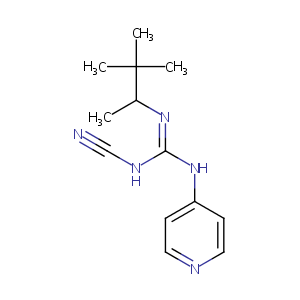Details of the Drug
General Information of Drug (ID: DMRADYL)
| Drug Name |
Pinacidil
|
||||||||||||||||||||||
|---|---|---|---|---|---|---|---|---|---|---|---|---|---|---|---|---|---|---|---|---|---|---|---|
| Synonyms |
Pinacidilum; P 1134; S 1230; P-154; Pinacidil (anhydrous); Pinacidilum [INN-Latin]; S-1230; N-Cyano-N'-4-pyridinyl-N''-(1,2,2-trimethylpropyl)guanidine; Guanidine, 2-cyano-3-(4-pyridyl)-1-(1,2,2-trimethylpropyl)-, monohydrate; Guanidine, N-cyano-N'-4-pyridinyl-N''-(1,2,2-trimethylpropyl)-, monohydrate; (+-)-Pinacidil; (+/-)-N-Cyano-N'-4-pyridinyl-N"-(1,2,2-trimethylpropyl)guanidine; (R,S)-Pinacidil; (inverted question mark)-N-Cyano-N'-4-pyridinyl-N''-(1,2,2-trimethylpropyl)-guanidine; 1-cyano-2-(3,3-dimethylbutan-2-yl)-3-pyridin-4-ylguanidine; 2-Cyano-3-(4-pyridinyl)-1-(1,2,2-trimethylpropyl)guanidine; 2-Cyano-3-(4-pyridyl)-1-(1,2,2-trimethylpropyl)guanidine monohydrate
|
||||||||||||||||||||||
| Indication |
|
||||||||||||||||||||||
| Therapeutic Class |
Antihypertensive Agents
|
||||||||||||||||||||||
| Drug Type |
Small molecular drug
|
||||||||||||||||||||||
| Structure |
 |
||||||||||||||||||||||
| 3D MOL | 2D MOL | ||||||||||||||||||||||
| #Ro5 Violations (Lipinski): 0 | Molecular Weight (mw) | 245.32 | |||||||||||||||||||||
| Logarithm of the Partition Coefficient (xlogp) | 2.7 | ||||||||||||||||||||||
| Rotatable Bond Count (rotbonds) | 5 | ||||||||||||||||||||||
| Hydrogen Bond Donor Count (hbonddonor) | 2 | ||||||||||||||||||||||
| Hydrogen Bond Acceptor Count (hbondacc) | 3 | ||||||||||||||||||||||
| ADMET Property |
|
||||||||||||||||||||||
| Chemical Identifiers |
|
||||||||||||||||||||||
| Cross-matching ID | |||||||||||||||||||||||
| Combinatorial Drugs (CBD) | Click to Jump to the Detailed CBD Information of This Drug | ||||||||||||||||||||||
Molecular Interaction Atlas of This Drug
 Drug Therapeutic Target (DTT) |
|
||||||||||||||||||||||||||
|---|---|---|---|---|---|---|---|---|---|---|---|---|---|---|---|---|---|---|---|---|---|---|---|---|---|---|---|
 Drug-Metabolizing Enzyme (DME) |
|
||||||||||||||||||||||||||
| Molecular Interaction Atlas (MIA) | |||||||||||||||||||||||||||
References
